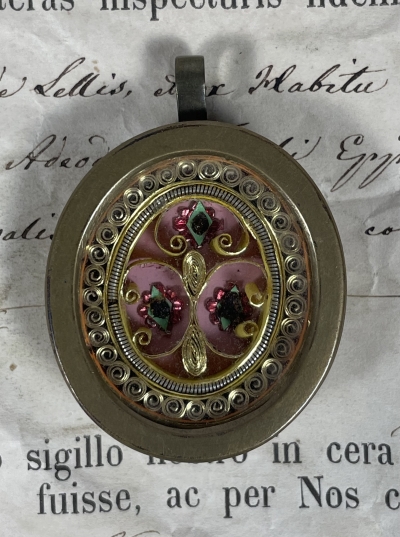According to tradition, the Veil of the Blessed Virgin Mary was worn by the Virgin as she stood at the foot of the Cross. It had been transferred in the early years of Christianity from Jerusalem to Constantinople when it was presented by the Byzantine Empress Irene to the Holy Roman Emperor Charlemagne. In 876 his descendant Charles the Bald gave the relic to the cathedral at Chartres. The Veil is kept in a golden reliquary beside the high altar and has formed the focus of many traditions throughout the centuries. It was believed to have protected the faithful down through the centuries from many dangers and evils, including famine and war, outbreaks of the plague, and the worst ravishes of the French Revolution. The veil itself is more than six meters long and made of silk. Scientific studies have shown that it is of Syrian design, of fine quality, and can be traced to the first century. Every year on 15th August, the Feast of the Assumption of Our Lady, the Veil is processed through the town of Chartres.
Saint Camillus de Lellis, M.I., († 1614) was an Italian priest who founded a religious Order of Clerks Regular, Ministers of the Infirm (abbreviated as M.I.), better known as the Camillians dedicated to the care of the sick. Camillus was beatified by Pope Benedict XIV in the year 1742, and canonized by him four years later in 1746. His mortal remains are located in the altar in the Church of St. Mary Magdalene in Rome, along with several of his relics. He is a holy patron of the sick, hospitals, nurses, and physicians and invoked to assist with gambling. His feast day is commemorated on July 14th.
Saint Barbara, known in the Eastern Orthodox Church as the Great Martyr Barbara, was an early Christian saint and martyr who is venerated as one of the Fourteen Holy Helpers. Accounts place her in the 3rd century in Nicomedia, present-day Turkey or in Heliopolis of Phoenicia, present-day Baalbek, Lebanon. She is a holy patron of Armourers, Architects, Artillerymen, Firemen, Mathematicians, Miners, and Prisoners.






 Change language to English
Change language to English